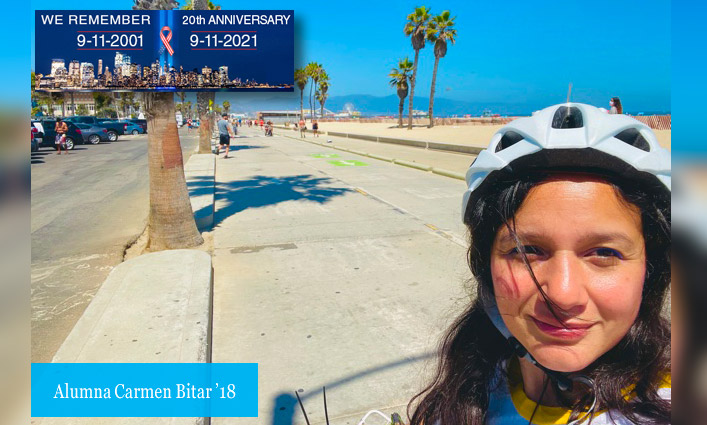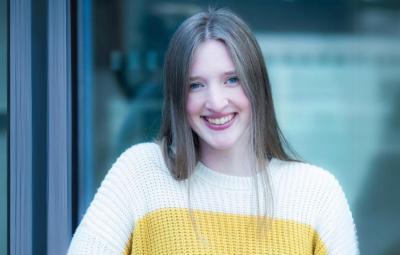
On the morning of September 11, 2001, John Jay alumna Carmen Bitar ’18 got up, picked out what she was going to wear—a dainty pair of mules instead of her sturdy hiking sandals—and she headed to her job at a high school located one block away from the World Trade Center. “After dropping my son off at his school in Queens, I quickly jumped on the train and made my way to Manhattan because I had to clock in at work at 8:45 a.m. I came out of the Fulton Street subway station and turned left on Broadway. Just as I made that left, I saw people at a standstill, looking up,” recalls Bitar. “I thought it was so strange because people, especially at that time of the day, are usually rushing around trying to get to their destination.”
Determined to make it to work on time, Bitar continued her walk toward the school. “Just as I approached the corner of Broadway, people started running and screaming. I still had no idea what was going on, but I knew that this wasn’t normal, so I moved with the crowd and hid inside a store.” Finding herself among strangers, Bitar looked around at the faces of those around her searching for answers. “One person had a cellphone, this was back when not too many people had cellphones, and he got on the phone and said, ‘I don’t know what just happened but I’m getting the hell out of New York.’ Physically, I couldn’t see anything from the store, but it was clear something bad was happening.”
“I could see the fireball engulf the top of the tower and pieces of the tower tumbling down.” —Carmen Bitar
Rushing For Her Life
A few minutes later, people in the store began to make their way out onto the street and Bitar soon followed. “I thought, it’s alright, it’s safe, I can go back out there. So, I left the store and continued west on Dey Street, that’s when I looked up, and directly in front of me I saw the North Tower was on fire. The hole was just so massive, you could feel the heat from the fire. I didn’t know what to think,” she says. Not wanting to get closer to the site—and the extreme heat emitting from the tower—Bitar called the main office at her job. “I tried the payphone on the corner, but because the communication antennas at the tower were hit, almost no phone calls were going through and those that did were quickly dropped.” It was in that moment she made an important decision, one that possibly saved her life. “I decided I couldn’t stay there, I had to leave lower Manhattan. I needed to turn around, go back to Queens, and get to my son immediately,” she says. “I was on my way back to the subway station when I felt the ground shake. That’s when the second tower was hit. I could see the fireball engulf the top of the tower and pieces of the tower tumbling down. I thought run. But I couldn’t run because of my shoes, so I started rushing as fast as I could toward the seaport, thinking if this gets worse, just jump in the water. You need to get to your son. That was the one thing clearly going through my mind. I needed to get to my son.”
Trying to Get Home
While she didn’t have much time to process what she just witnessed, Bitar knew she had to find a way out of lower Manhattan amidst the chaos. “At the seaport, I heard people saying they were going to walk across the bridges. I knew the Brooklyn Bridge would be packed because it was the bridge closest to us. Instead, I made my way up to the Williamsburg Bridge.” As she crossed the bridge, something told Bitar to glance back at the towers. “I was in the middle of the walkway when I turned around and saw just one of the towers, the North Tower. I thought that maybe the angle I was looking from made it so I could only see the one tower. But then, all of a sudden, the tower started to collapse. Everyone started screaming and running,” says Bitar, adding that the fear on the bridge only continued to grow. “As people are running, someone said that there was a bomb on the bridge. We all began to move even faster now, which was really tough for me since my shoes were so hard to run in. But the fear and adrenaline to survive just kicked in.” After running as fast as she could in backless shoes across the bridge and then walking for hours, Bitar finally made it to her son’s school and was informed that he wasn’t there. “That’s when the panic set in. On top of what I had just witnessed and experienced, I now had no clue where my son was,” she says, reliving the moment. “Thankfully, the school worker brought over the sign-out sheet, and I saw that my sister had picked him up.”

The shoes Bitar wore on 9/11
“Once I was home, I took off my shoes and just broke down. I couldn’t stop crying, not only for what I saw and had been through, but for this horrific tragedy and all the lives lost.” —Carmen Bitar
Learning What Happened
It wasn’t until hours later that Bitar began to learn about the events that unfolded that morning—the two hijacked planes that struck the twin towers at the World Trade Center, the hijacked plane that was crashed into the Pentagon, and a fourth hijacked plane, Flight 93, that crashed at a field in Shanksville, Pennsylvania, following the heroic acts of the passengers on board. “Once I was home, I took off my shoes and just broke down. I couldn’t stop crying, not only for what I saw and had been through, but for this horrific tragedy and all the lives lost,” she says, noting that she put the shoes in a bag and never wore them again.
In the days and weeks that followed, Bitar’s school relocated students and staff to another school site in midtown—“even from our new location, the smell from ground zero lingered”—and she learned from colleagues what happened at the school on that tragic day. “One of my colleagues told me that as she got out of the train station at the World Trade Center stop, she saw the people jumping to their deaths,” says Bitar with sadness in her voice. “I know I’m lucky because I didn’t see that.” She also learned that students and staff weren’t released until after the second tower fell. “They had to walk through all the dust and debris. Some of my colleagues now have 9/11-related diseases and cancers,” says Bitar, aware of how fortunate she was. “Deciding to turn around and go home saved me in more ways than one.”
By sharing her story, Bitar hopes others will talk about their 9/11 experience also. “It’s a day etched in so many of our memories. Whether you were at the World Trade Center site, observing the tragedy as it happened from your school window in the tri-state area, or watching it on TV, I think it’s important to remember that 9/11 happened to all of us,” she says. “We need these stories to live on from generation to generation. We need to remember and honor those who were lost. It’s a tragedy and a day we should never forget.”



